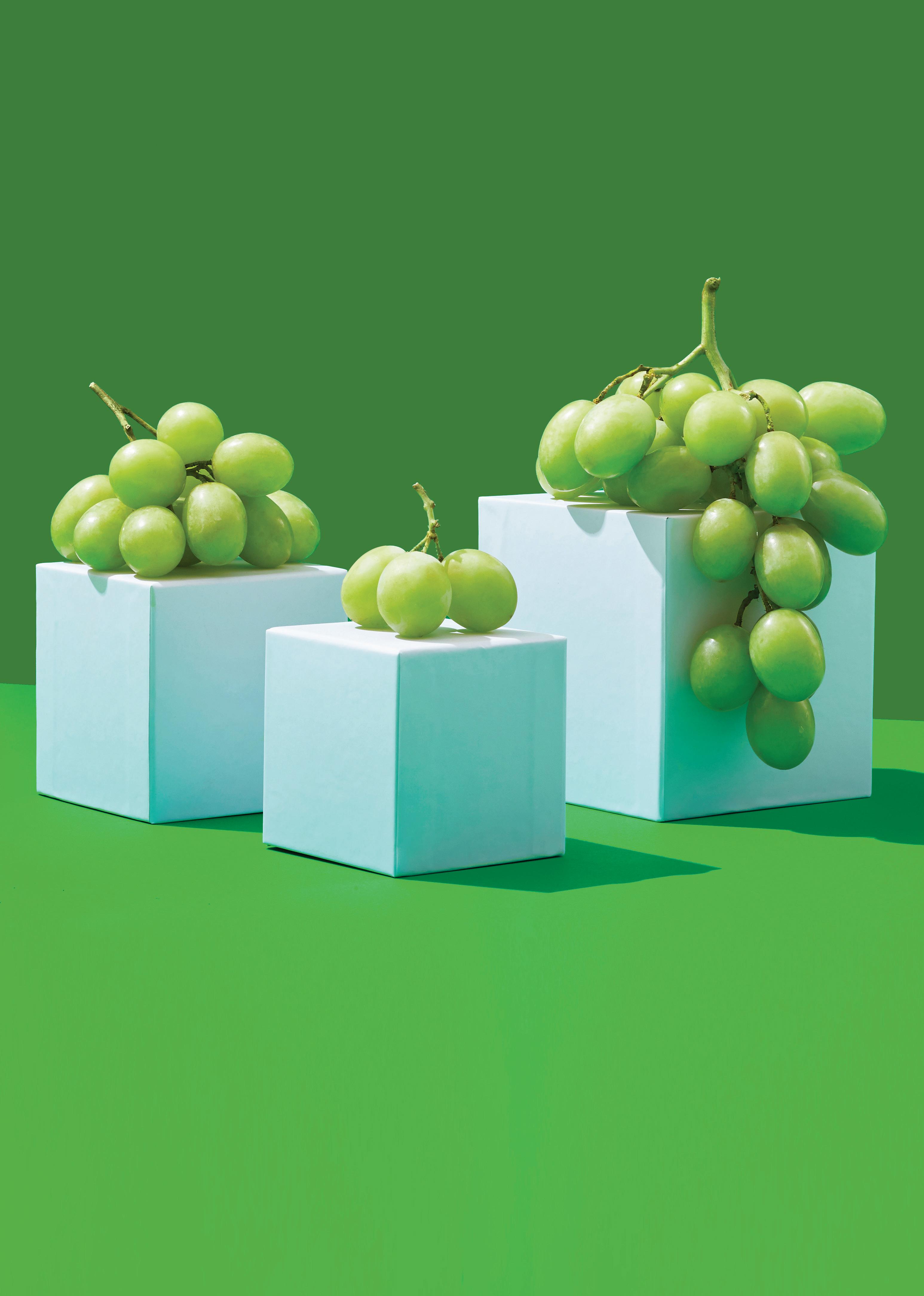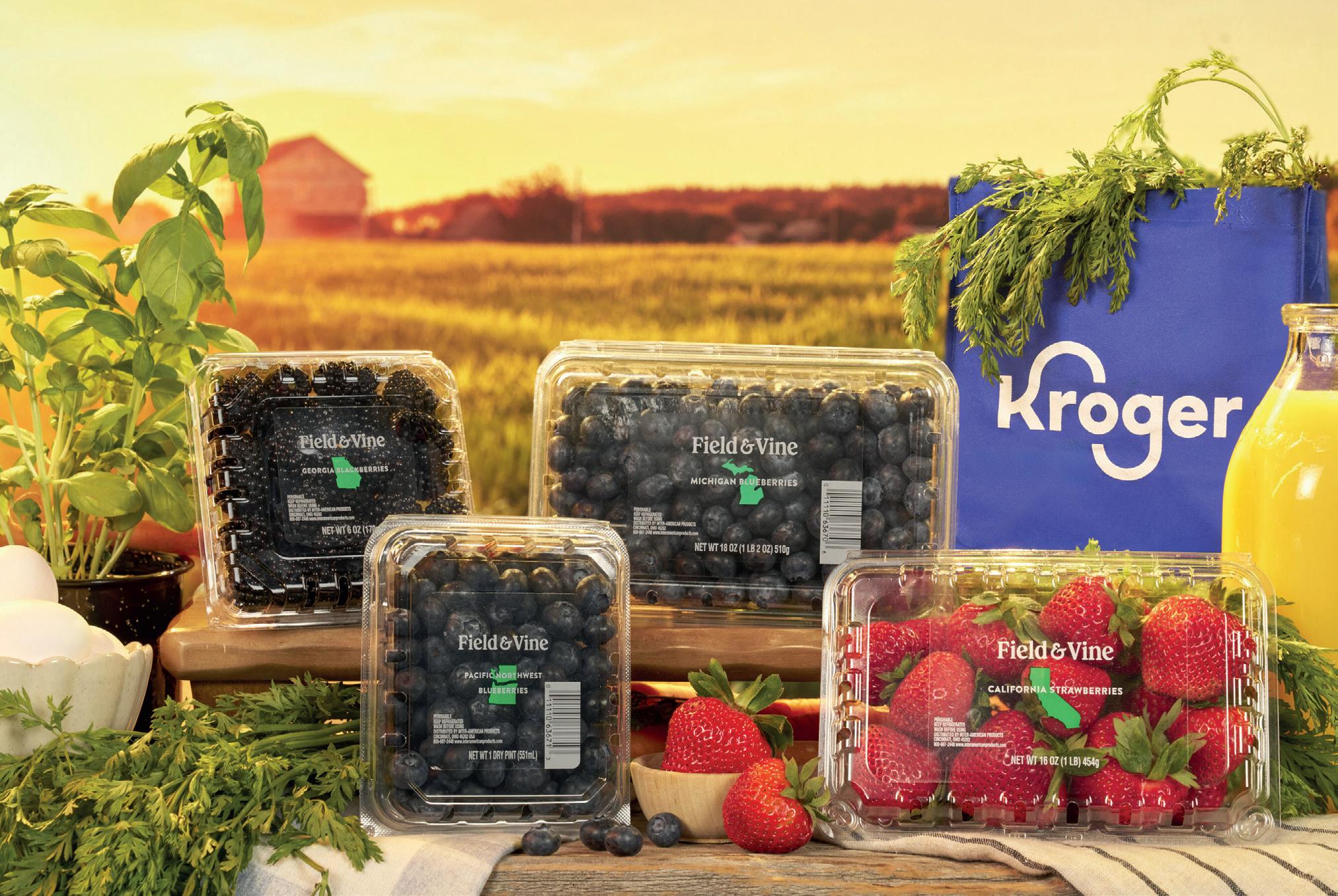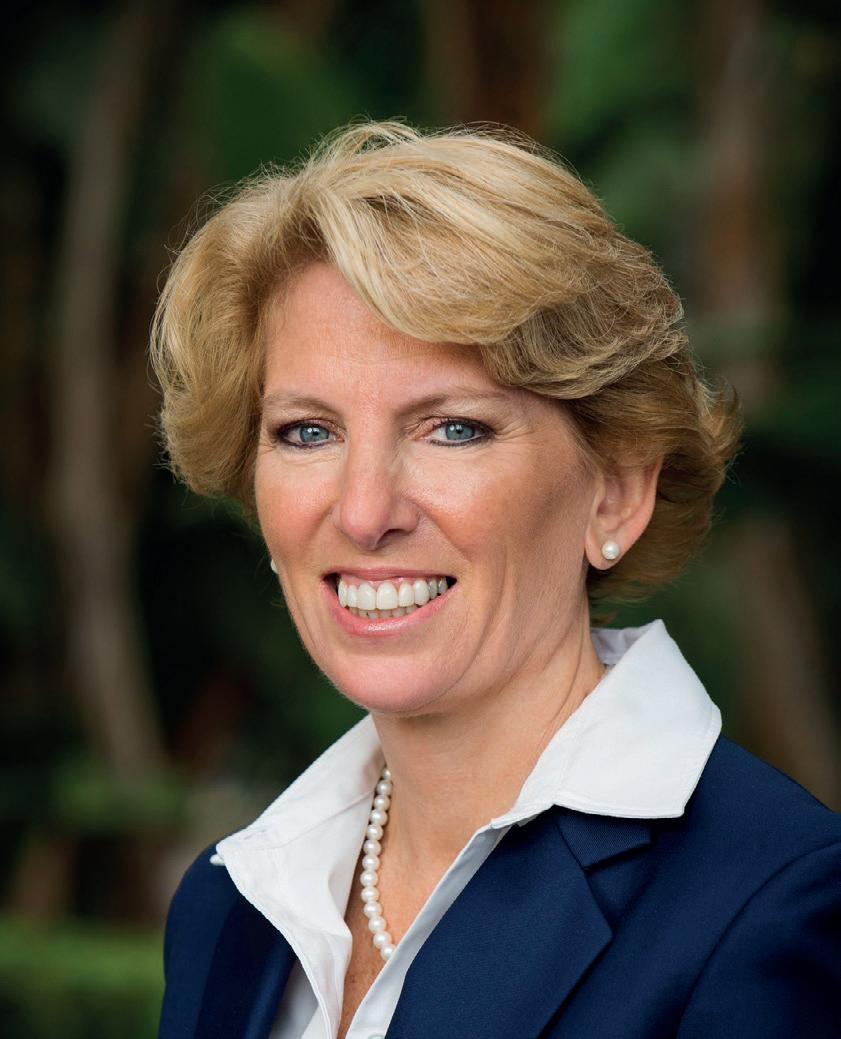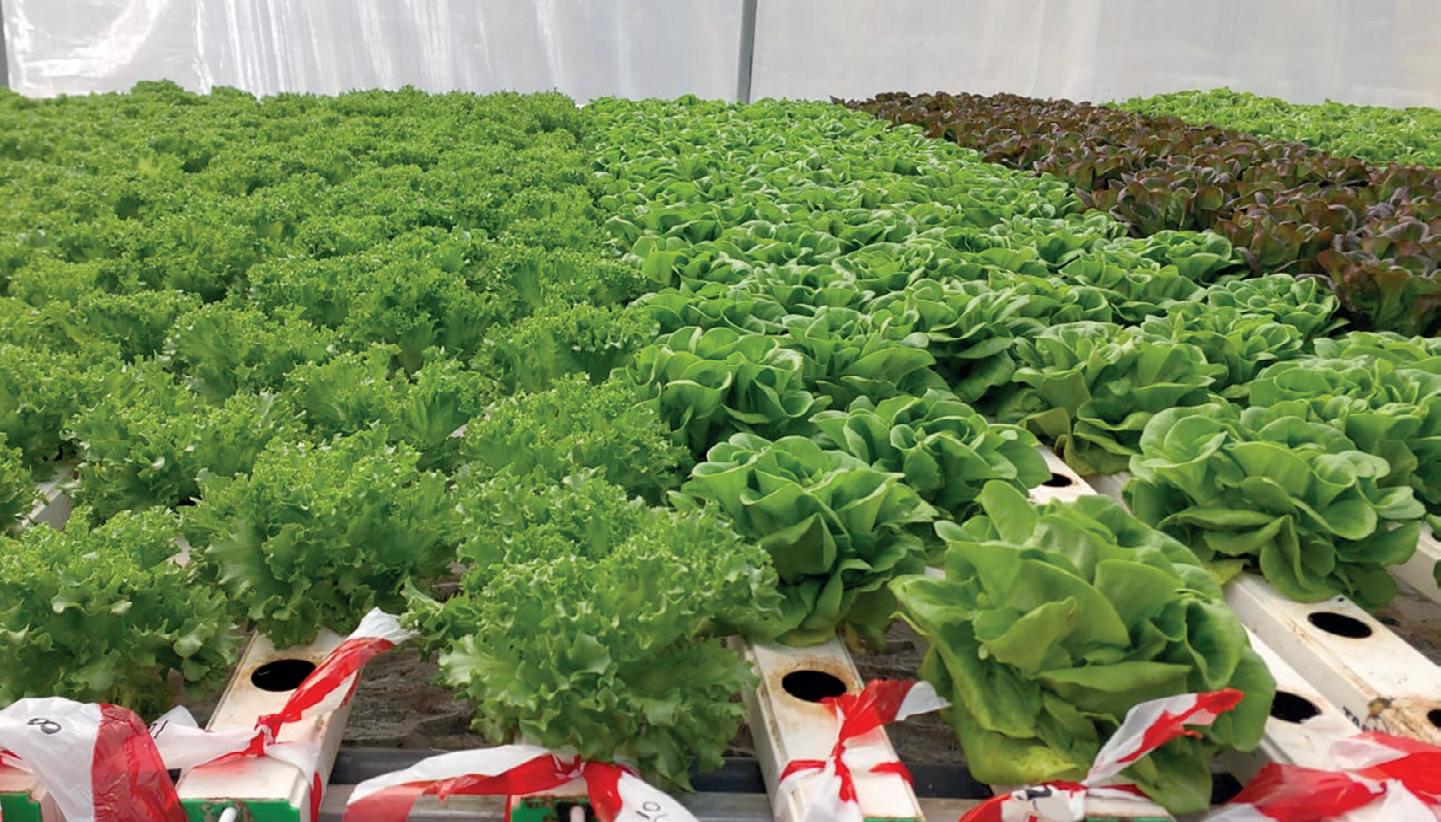NORTH AMERICA
PUBLISHED BY



PUBLISHED BY


Exciting trends and emerging opportunities remain a defining characteristic of the US and Canada produce markets
One would be forgiven for thinking that growth in the global fresh produce market these days is all about Asia. But in North America too, new trends are emerging and fresh commercial opportunities abound. This Fresh Focus North America special proves that very point over the next 30+ pages. Our exclusive interview with renowned breeding expert David Marguleas of Sun World shows there is major momentum when it comes to new product development in citrus, cherries, and mangoes. You can read about good potential for growth ahead in the avocado market too, and hear from plenty of other international suppliers who see excellent prospects in the US and Canada for items including South African grapes, Australian citrus, Latin American tropicals, and Mexican berries. In the North American market itself, there are some big challenges: for example, when it comes to sustainability in areas like packaging, or safeguarding access for imports. But as our interviews with John Anderson and Cathy Burns of the IFPA and Ron Lemaire of CPMA show, there is also considerable resolve and positivity within these countries’ produce industries. We very much look forward to seeing that confidence and optimism on display on 17-19 October at the Global Produce & Floral Show in Atlanta.

Mike Knowles, Editor
Fresh Focus North America talks to Sun World CEO David Marguleas about what the company’s acquisition of Biogold will mean for growers, retailers and consumers.
by Maura Maxwell

David, the Biogold deal marks a significant expansion of Sun World’s portfolio with the inclusion of citrus and subtropicals. These products were already on your radar – in 2021, Sun World hired breeder Moises Gonzalez to begin new breeding programmes in citrus, mango and avocado. What opportunities do you see in these categories?
DM: We’ve been successfully developing new varieties of table grapes and stonefruit for many years and wanted to identify crops that were underserved in the breeding world, both at the public level with government and university breeding programmes, as well as in the private sector.
We identified a few crops that, despite being major economic drivers in the fruit industry, didn’t attract quite as much attention in the breeding and research sector, those being citrus, avocado and mangoes. They are often grown in close proximity with table grapes and stonefruit, and we felt that with our own expertise in bringing new varieties to the marketplace, we could make a difference in these categories, particularly in citrus and mangoes.
What about avocados? Given that Hass accounts for the bulk of the global trade, where do you see the opportunities in this category?
DM: Biogold holds the rights to one of the largest collections of avocado varieties and germplasm in the world and we’re hopeful that its collection will result in some new varieties that resemble Hass, but improve upon its seasonality, shelf-life and eating quality.
What timescale are we looking at in terms of commercial launch of these varieties?
DM: I think the nearest term opportunities for us resulting from the Biogold acquisition are in the mango category. Citrus breeding programme would be next –I would call that mid-term, maybe three to five years. Avocados would be a little further out, perhaps five to ten years.
So can we expect to see some new mango varieties hit the market in the next couple of years?
DM: Yes, I believe the combination of a variety that Sun World owns, some of the initial work that Moises Gonzalez has been doing in the mango area, and a number of potentially commercial varieties that come with the Biogold acquisition should enable us to make some introductions in the next couple of years.
Mangoes are one of the most widely consumed fruits in the world, but there has not been a tremendous amount of innovation in the category, which is why we think there’s a huge opportunity here.
What are the specific characteristics that you are focusing on when it comes to the development of new mango varieties?
DM: A lower fibre content, thinner seed, more edible fruit, more vibrant exterior blush and that creamy flavour that people appreciate in a number of mango varieties that are grown round the world. There are also several diseases that impact mango production, so we’re looking at disease resistance traits and climate resilient traits that will enable growers to withstand some of the drought conditions and wild variations in temperatures that we’ve experienced in recent years.
Are you planning to go down the same route as with table grapes in terms of developing consumer branding for your new varietal launches?
DM: We certainly think there are opportunities to develop consumer brands for a number of varieties that we’ll be introducing in the coming years, much as

we’ve been doing in table grapes with Autumncrisp and Ruby Rush, and with our red-fleshed Black Diamond plum line. So yes, branding will be an important part of those introductions.
In citrus, you say you want to develop speciality varieties. Which areas are you focusing on?
DM: One of the main focal points for Biogold has been around easy peelers, in particular mandarins. This has been one of the few growth areas in the citrus category post-Covid. We are excited about continuing the work that Biogold has done with a number of public and private breeders in this area. There are opportunities to extend the season to both precede and follow popular varieties like Nadorcott and Tango, and to introduce truly seedless versions of easy-peel mandarins.
The other category that we see a lot promise in is the lemon category, which has been relatively stagnant in recent years. We’ve very encouraged by the growth in the seedless lemon category, and in particular there are several varieties that Biogold manages for third-party breeders that have met with a great deal of success in North America as well as
ABOVE— Sun World CEO David Marguleas
and president and COO Bernardo Calvo
in Europe.
The third area we’re looking at is red pigmented mandarins and oranges. We see great opportunities based on the varieties that we’ve been evaluating that Biogold has been working with in recent years.
There’s a fourth category that I wouldn’t assign quite the same importance to but that we feel has some potential, and that is the grapefruit category. This has been fairly anaemic over the last 20-30 years as the use of statins has discouraged people from eating a lot of grapefruit and the tartness of the fruit hasn’t appealed to younger consumers.
Biogold is evaluating several grapefruit varieties with lower acid content and higher brix, and with a deeper red pigmentation both in the flesh and on the skin. We’re hoping to revive the grapefruit category with some of these characteristics.
What about disease resistance – is this also an integral part of your citrus breeding efforts? »
KEYNOTE INTERVIEW
DM: Sustainability has been critical to Sun World in the grape and stonefruit categories and it’s just as important in the citrus and subtropicals categories. We’ve been working on resistance and tolerance to both diseases and pests, as well as climate resilience. HLBis a major concern to citrus growers globally and many of the public and private breeders that Biogold represents have been doing some meaningful work in this area.
With the development of new technologies, breeding has essentially become a numbers game – the bigger your germplasm collection, the faster you get new varieties to market. Will we see more consolidation in the sector?
DM: There’s no question we’ve made meaningful progress in science and technology. We can apply some of those learnings to citrus and subtropicals, along with table grapes and stonefruit.
The use of new technologies like molecular breeding to build on our four decades of work around plant breeding should position us in a positive way with retailers and consumers that are looking for varieties with new traits.
For example, traits such as disease and pest resistance and climate resilience should enable us to develop new varieties that can be grown in non-traditional areas. In cherries, we’ve been working on a line that is more resistant to higher temperatures and can be grown in non-traditional areas on the shoulders of the season, when supply is lowest. Similarly, the ability to produce new citrus in more drought-like or warmer conditions is another area where we’ve tried to use technology. Things like AI and predictive analytics and molecular breeding are important tools in our toolbox. Coupled with the 45 years of conventional breeding that we’ve done, this gives us lots of hope.
How has Sun World positioned itself to take full advantage of these technological advances?
DM: In addition to the varieties that Biogold brings to Sun World, there are also several dozen people that have been working at Biogold around the world in many of the same locations as our own team members, in the major fruit growing regions. So we’re excited about bringing the two companies together, in particular the two cultures of the business.
The other exciting change in recent years is bringing on a more robust management team to help introduce a lot of these new varieties to growers and retailers around the world. We’ve staffed up our management and leadership teams and we’ve had the privilege of bringing in a number of highprofile board members, who have particular expertise in fields like AI, the breeding of speciality crops.
For example, Dr Elliot Grant, is an expert in AI who used to run one of Google’s portfolio of companies in the horticultural space. And Sebastian Langbehn is one of our directors who came from Monsanto and Bayer in the speciality vegetable world. And then there is former Secretary of Agriculture Anne Veneman, who has also come on board as an independent director. Each has been invaluable to me and the rest of the executive team.
Are growers concerned that consolidation in breeding could put commercial pressure on them?
DM: The initial reaction from the grower community to the Biogold deal has been overwhelmingly positive. We spent a week with over 300 producers [at Sun World’s table grape field days in Bakersfield, California] and we continue to hear lots of enthusiasm for bringing them more innovation across the horticultural industry.
For many years, our table grape growers have asked us to get involved in other products like citrus and mangoes. During our field days, we began discussions with a number of large table grape growers that are also eager to plant new citrus and mango varieties –particularly in countries where those crops are grown adjacent to one another. These are growers that have been reluctant to plant mandarins or mangoes because of the dearth of innovation in this area.

DM: Our initial focus is to build out the cherry, mango, citrus, and grape programmes that we have, and to look for partners that enable us to offer growers innovation and more sustainability in their businesses. So you can expect to see extensions of existing grape lines with varieties that resemble Autumncrisp, that precede and follow it in the marketplace, as well as the cherry lines that I mentioned, and then mangoes, which are probably one of our more near-term development opportunities given the size and success of the Biogold mango breeding programme.
Biogold is primarily a varietal rights management company that represents third party breeders. We have been fielding several enquiries from other breeders that are looking to have us help them commercialise their lines. That’s one area of opportunity. The other is to find complementary crops that are underserved in the marketplace where we can be of help.












GIVE THEM SOMETHING FRESH TO TALK ABOUT.
With increased acreage and global cultivation, AUTUMNCRISP ® grapes are now available year-round. Freshen up your produce picks with Sun World’s most irresistibly CRISP green grapes, AUTUMNCRISP ®
Scan QR code to learn more.




A new transatlantic logistics service is gearing up to transport EU fresh produce from the Port of Antwerp to Pennsylvania, as Benelux exporters eye niche trade opportunities in certain vegetable categories.
by Fred Searle
Foodcareplus, a Belgian provider of fresh produce logistics services, is preparing to launch a comprehensive new service for the consolidated shipping of fruit and vegetables from the Benelux and France to the US.
The pioneering new offer, called Fresh Produce Express Service, is a collaboration with third-party logistics provider Sunrise Logistics and Independent Container Line. Its start date will be announced at the Global Produce & Flora Show in Atlanta on 17-19 October.
The streamlined service will truck produce from a consolidation point in the Belgian town of SintKatelijne-Waver to the Port of Antwerp. From there, goods will be shipped to Penn Terminals near Philadelphia, before being transferred by road to the Sunrise Logistics coldstorage facility in Ephrata, Pennsylvania. The Sunrise depot spans approximately 400,000ft2 and can accommodate all kinds of fresh produce at a wide range of temperatures. It also offers packing and ripening services, as well as quality control and on-site USDA inspections.
Foodcareplus says the total transit time will be roughly two weeks, leaving enough time to market the produce through wholesale and retail channels in the US. The fresh produce will be shipped in mixed containers, allowing EU exporters to supply US wholesalers and complement larger

volumes from domestic and Latin American suppliers.
In the US, wholesale remains an important channel and supplies all major supermarkets, as well as the independent retail market. Doing business directly with big US supermarkets generally isn’t possible unless a supplier sends large volumes of produce.
So the aim of the Fresh Produce Express Service is essentially to allow EU producers to act like a domestic supplier. Foodcareplus will handle all transit costs and paperwork involved, enabling them to have a more direct relationship with US wholesalers.
Foodcareplus co-director Steve Alaerts stresses, however, that the European exporter still bears
the risk if produce is delayed or damaged in transit.
Diego Barriga, who works alongside Alaerts as Foodcareplus’s other director, explains: “As part of our commitment to providing a seamless and efficient service, we’ve ensured that the Fresh Produce Express Service offers comprehensive integration with our shipping partners. This allows for smooth coordination between the consolidation of produce in Belgium and its timely arrival in the US market. The partnership with Independent Container Line and Sunrise Logistics ensures that every step, from shipment to distribution, is streamlined to maintain the highest standards of freshness and reliability.”
ABOVE—The Fresh Produce Express Service will export fruit and vegetables via the Port of Antwerp
OPPOSITE
MIDDLE—Steve Alaerts of Foodcareplus
OPPOSITE
BOTTOM—Alaerts sees market opportunities for Brussels sprouts on America’s east coast
The new logistics service aims to capitalise on new market opportunities for certain EU produce in the US, particularly vegetables. Alaerts says there is “a brilliant opportunity to complement the US market, especially on the east coast, with produce from Belgium, such as Brussels sprouts and endives”.
He adds that European vegetables more generally, and particularly root veg, have strong potential in US markets due to growing demand from European diaspora communities. In cities like Chicago, with large European-origin populations, these communities seek familiar items that suit their culinary traditions. This creates considerable opportunities for EU exporters.
Over the last ten years, fresh produce imports to the US have risen by 26 per cent in volume –mainly from other countries in the Americas such as Mexico, Peru, Chile, Guatemala and Costa Rica. But Alaerts sees opportunities for EU produce to enter the market too, albeit in smaller volumes.
As it stands, the EU accounts for just 0.4 per cent of fresh produce imports to the US. This amounted to just 37,000 tonnes (€84.5m) in 2023. There were no import volumes from Belgium to speak of, and only minimal volumes from the Netherlands.
Nevertheless, Tineke Van de Voorde of the Port of Antwerp echoes Alaerts’ optimism, saying the US is a “dynamic market that is increasingly diversifying its sources of fresh produce”.
Mike Laws of Sunrise Logistics notes that American retailers generally prefer to buy produce domestically if possible – since costs and supplies are more predictable, and because there is a complex regulatory landscape for agricultural imports to the States.
However, if the price and quality of imports can match or beat domestic produce, Laws sees real opportunities for EU produce to fill gaps in domestic US production – provided it can be delivered efficiently to the retailer’s door.
Laws adds that EU imports give the US wholesale and foodservice sectors an excellent opportunity to add value to their customers by providing access to produce that would normally be in limited supply.
Commenting on the current state of the US fresh produce market, the International Fresh Produce Association (IFPA) notes that due to the cost-of-living crisis, US shoppers are switching spend to the discounters and shopping around for better deals. However, research shows that quality and perceived value remain paramount to consumers.
US household penetration in fruit and vegetables was steady in 2023, with consumers buying fresh produce 67.4 times a year, up 0.2 per cent on 2022. Anouk Sijmonsma of the IFPA says there are opportunities to expand sales to baby boomers, as they are less well understood by US brands and retailers, and families with children, who can be encouraged to snack on fruit and veg from an early age.
Jeroen Buyck is CEO of Belgian fresh produce exporter Calsa and president of Fresh Trade Belgium. He says the organisation
will support the new service as much as possible because it makes exports more efficient and costeffective in the face of restrictive EU regulations and the “oligopoly” of global logistics companies and container lines.
In most fruits and vegetables, the EU already has the necessary permits and phytosanitary certificates to access the US market, but in some vegetables – like celeriac, parsnips, radishes and beetroot – no prior request has been made to the US Food and Drug Administration, which regulates imports. Nevertheless, Foodcareplus assures European exporters that this is unlikely to prove a major hurdle.




A multitude of global supply issues have limited citrus availability on the European market. But a recovery is around the corner.

TJUAN GONZÁLEZ PITA Salix Fruits Chief operating officer
he impact of frost and other weather events in the Southern Hemisphere is severely affecting the availability and quality of citrus right now. In addition, tensions in the Red Sea region are causing significant delays in maritime traffic, which in turn is generating a notable distortion in markets, either due to an oversupply or a shortage of products due to extremely long transit times.
Moreover, the Huanglongbing (HLB) situation in Brazil and Florida remains critical in 2024, with significant impacts on orange production and, consequently, on the global supply of orange juice.
In Brazil, the incidence of HLB has increased considerably, affecting more than 38 per cent of trees in major producing regions such as São Paulo and Minas Gerais. The lack of removal of diseased plants has exacerbated the problem, making it increasingly difficult to control the disease and renew orchards. In addition, resistance to certain insecticides has been reported in HLB vector insects, further complicating disease management. Despite efforts, the situation is described as “alarming”, with a direct impact on reduced orange production and fruit quality
In Florida, the situation is equally serious. Orange production has declined dramatically, with a reduction of almost 80 per cent compared to pre-HLB levels. The focus on insect control and the lack of effective eradication of diseased trees have contributed to the continued spread of the disease. The combination of HLB and other factors, such as climate change, have left Florida’s citrus industry in a very vulnerable position.
This situation has led to a decrease in the global supply of oranges and orange juice, which has contributed to rising prices on the global market.
In this context, the decrease in the global supply of oranges and orange juice is observed, as well as in the sizes of citrus, which are smaller than usual. Prices are therefore rising due to strong demand in key markets such as the US and Latin America. These factors represent significant challenges for the season destined for Europe and Russia. However, adverse weather conditions in Argentina and South Africa are also creating good trading opportunities, despite the difficulties mentioned above.
The citrus market is determined by the supply of the product and not by demand. Demand is generally very “inelastic”, especially for lemons and limes, although perhaps a little less so for sweet citrus. Therefore, it will be necessary to see how supply reacts and, based on that, how demand behaves, as supply will determine the price and, from there, drive demand accordingly. However, this year we anticipate a recovery in citrus volumes from almost all origins. After last year’s climatic challenges, such as the El Niño phenomenon in Peru, we are prepared for a significant increase in our supply.
BELOW—Adverse weather has severely impacted citrus volumes out of the Southern Hemisphere


Growers from 18 countries attend inauguration of state-ofthe-art breeding facility for grapes, cherries and raisins.
by Jeff Long

International fruit breeder Bloom Fresh inaugurated its state-of-the-art research and development facility north of Bakersfield, California, in August, hosting hundreds of growers hailing from 18 countries from around the world.
The US$14m complex, dubbed the ‘Discovery Centre’ by the UK-based company, “will serve as a hub for the innovation, creation, and breeding of new table grapes, cherries and raisins,” according to a press release. The site includes 150 acres (60ha) of vineyards and orchards for testing new cultivars, 28,000ft² of laboratory space and 25,000ft² of greenhouses.
Attendees were taken on tours of vineyards, viewing some of Bloom Fresh’s most promising varieties, several of which are already branded with catchy monikers such as Bebop and Rugby
ABOVE—The US$14m complex is dubbed the Discovery Centre
Spain’s Uvasdoce Fresh has launched Mojito Fresh, a new table grape variety developed by Bloom Fresh with a unique flavour profile that combines sweet spearmint notes with a mix of Moscatel and labrusca. The variety (pictured below) will be available across major retailers in Spain, including Consum, Carrefour, and Alcampo.
The variety’s Mojito-like flavour was the inspiration for the creation of a new collection of grapes aimed at young adults and adults seeking a healthy, permissive treat entitled the Fresh Mocktail Collection.
Bloom’s CEO Josep Estiarte commented: “We were pleased by the exciting opportunity to explore the variety of Mojito Fresh planted by our farming partner Uvasdoce Fresh. This collaboration allows us to connect with a new target of consumers and attract new shoppers to the table grape category”.
Miriam Cutillas, general manager of Uvasdoce Fresh, said: “This marks the beginning of a new season of delicious, natural, and healthy experiences to excite shoppers in the summer. We see immense potential in Mojito Fresh and look forward to future expansions”.
Alvaro Muñoz, CEO of parent company AMFresh, said: “At AMFresh our mission is to push the boundaries of innovation to entice and captivate consumers. The synergy between our genetic platform, Bloom Fresh, and our farming and retail services at Uvasdoce Fresh exemplifies our commitment to excellence”.

while others are yet to be named. The company’s flagship variety, Cotton Candy, was available for tasting during the morning-long programme.
The Bloom Fresh complex had been under construction since 2021 by International Fruit Genetics, which Bloom Fresh acquired last year. CEO Josep Estiarte said that merging the two fruit breeding giants has been an “interesting” experience.
“It’s a merger that is still ongoing,” Estiarte told Eurofruit “The two companies naturally had different styles of operating and we’re working through it. But it’s been a fun challenge and we’re getting closer to realising our dream every day.”
Estiarte said several red table grape varieties are getting
close to commercial release, which he believes will meet the requirements of an increasingly demanding marketplace.
“Consumer preferences continue to evolve and one of the things they are telling us is that they want more texture – or ‘crunchiness’ – in their grapes and we will soon be releasing varieties that deliver on this. Bloom Fresh also has several red-flesh varieties in development that are full of health-promoting antioxidants, which we are quite excited about.”
Sustainably grown produce is another market expectation. To that end, Bloom Fresh is working on table grape varieties that require far less use of agricultural chemicals.
“As much as 90 per cent less,” noted Estiarte. “Sustainability is
“Consumer preferences continue to evolve and one of the things they are telling us is that they want more texture”
one of our core objectives, as it is increasingly important to consumers. But using less chemicals will also be a great help to our growers who are struggling greatly with increased costs of production.”
























































































































Chilean grapes put in strong performance in 2023/24
Increase in export volume and value reflects renewed focus on quality, new varieties and improved logistics.
by Maura Maxwell
Chile exported 64m cartons of table grapes worth more than US$1bn FOB in 2023/24, representing a 7 per cent increase in volume and 13 per cent increase in value compared to the year-earlier period. The improved results came in spite of the drop in production caused by climatic issues.
Expressing his satisfaction with the results, Iván Marambio, president of Frutas de Chile said they reflected ongoing improvements in quality within the sector. “This season we also saw an increase in the production and export of new varieties, which accounted for 62 per cent of total shipments or 39m cartons,” he said.
Marambio noted that the strategy of the recently created Table Grape Committee to improve the sector’s competitiveness,
particularly in its main export market, the US, was paying off. “All of this was also enhanced by the drop in supply from California and Peru, due to adverse weather conditions that hit them harder than our country,” he said.
Two other variables help lift Chile’s results, Marambio said: firstly improved logistics, and secondly stable pricing in the US market, despite the greater supply that arrived from Chile from week 14 onwards.
Isabel Quiroz, executive director of iQonsulting, explained that although Chile’s varietal renewal had been slower than that of Peru’s and South Africa’s, the transition was now starting to bear fruit.
“It has been understood that there is no room for mediocre fruit, and that the table grape industry continues to be an attractive one as long as one is willing to compete in the big leagues,” she said.
The main new Chilean grape varieties are Sweet Globe (white seedless) with a share of 12 per cent, Allison (red seedless) with 11 per cent and Sweet Celebration (red seedless) with 10 per cent. The varieties that have shown exponential growth this last season were Sweet Globe, Autumn Crisp and Sweet Flavor, while Timco and Cotton Candy have decreased
“It has been understood by growers that there’s no room in the market for mediocre fruit”
their participation.
The improved table grape season helped lift overall fresh fruit exports to a new record in the first half of 2024. According to customs data, analysed by ProChile, shipments topped US$7bn between January and July, representing an increase of 9 per cent on the yearearlier period.
The outlook for the 2024/25 campaign is equally promising now that Chile has successfully secured a Systems Approach for table grape exports to the US after 24 years of negotiation. Under the new protocol, confirmed on 28 June, methyl bromide fumigation is replaced with a series of mitigation measures at source.
Two months later, Mexican plant health authorities announced their decision to extend a pilot plan allowing imports of Chilean grapes into the country under a Systems Approach. From 2024/25, grape producers in the regions of Atacama, Coquimbo and Valparaíso will be able to participate in the pilot.
Marambio said the eliminating fumigation would help the sector become more sustainable and allow it to export grapes with better quality, condition and competitiveness to the US and Mexican markets, benefitting Chilean producers and exporters, but also US and Mexican importers and consumers.


The marketer has emphasised its commitment to the foodservice arena as it continues to grow the market for tropical fruit in North America.
by Mike Knowles
Mission Produce says it wants to inspire even more chefs to include avocados and mangoes in their menus and make their dishes even more special.
“Avocados and mangoes are versatile ingredients with opportunities to be incorporated across more of the menu”
That was the company’s standout message as it headed to Monterey in California earlier this year for the International Fresh Produce Association’s annual Foodservice Conference.
Mission’s recipe for success is simple. By mastering the art of ripening avocados and mangoes so they are in prime condition, it aims to offer customers all across North America’s foodservice market guaranteed freshness and perfect ripeness.
For Galen Johnson, the group’s senior director of foodservice and wholesale sales, the foodservice sector is very much a catalyst for innovation when it comes to these high-care tropical fruits.
“Foodservice often introduces consumers to their first taste of new flavours and ingredients,” says
Johnson. “And at Mission Produce, we know the quality of those ingredients is the foundation of creating a positive dining experience. That’s why we’re committed to delivering the world’s finest avocados and mangoes, expertly ripened and ready for preparation.”
According to research quoted by the company, an overwhelming majority (97.2 per cent) of avocado consumers are willing to pay more to add avocados to their dish; and
two-thirds of them are willing to pay US$2.00 or more.
When it comes to mangoes, meanwhile, mentions of the fruit on menus have reportedly grown by 7 per cent in the last four years, and it is now mentioned on 42 per cent of menus in the US.
“Avocados and mangoes are versatile ingredients with significant opportunities to be incorporated across more of the menu,” Johnson adds. “Both offer unique textures and flavours, as well as important health benefits.”
At the Foodservice Conference, the group offered samples of its “expertly ripened” avocados and mangoes, a move designed to showcase the quality of its fruit and to inspire more culinary creations featuring those items.
Mission recently revealed that its total revenue grew 24 per cent year-on-year to US$324m during the third quarter of 2024. That increase was primarily driven by its marketing and distribution segment, it said, where average perunit avocado sales prices were up 36 per cent.
This increase more than offset a 10 per cent decrease in avocado volume sold – the result of lower avocado supply caused by recent adverse in Peru and disruption to harvesting in Mexico.
Despite the volume reduction, domestic sales volumes were relatively flat during the quarter, ”demonstrating the resiliency of demand for avocados amid higher price points in the US market”.
Colombia Avocado Board says triple-digit growth has been registered, with US demand a major contributing factor.
by Carl Collen
The Colombia Avocado Board (CAB) has announced triple-digit growth in total volumes sent to the US during the first semester of 2024, compared with the same period last year. The growth was based on a review of the Hass Avocado Board (HAB) Volume Data Dashboard and Category Data Dashboard.
CAB pointed out that avocado consumption has been steadily climbing over the past decade, with the US now the world’s largest importer of the fruit. This growing appetite for avocados, along with the expansion of Colombian acreage and maturity of its trees since market entry in 2020, continues to yield dividends for the country’s producers, exporters and importers, it noted.
“This remarkable growth in demand for Colombian avocados
in the US highlights the improved quality and reliability of our produce and confidence in our production,” said Manuel Michel, managing director of CAB. “It also reflects the increasing consumer preference for avocados yearround, creating opportunities for more suppliers. We are proud that Colombia is starting to play a key role in meeting this demand.”
Markets east of the Mississippi continued to see ”exceptional growth” and are priority markets for Colombian avocados due to their market proximity, CAB confirmed.
Evaluation of the HAB market category data shows avocado unit sales growth in major US cities in the east like Miami (15.98 per cent), Boston (14.12 per cent), Louisville (9.55 per cent), Cincinnati (6.36 per cent), and Baltimore/Washington D.C. (4.93 per cent).


“The unprecedented growth of Colombian avocados to the US during the first semester of 2024 contributed to this increase and highlights the growing recognition of Colombian avocados as an important partner in avocado supply,” said Ricardo Uribe, chairman CAB.
“We are thrilled to see strong demand as more American consumers discover the exceptional quality and taste of our avocados,” he added. “This is just the beginning of Colombia’s role as a major player in the US avocado market.”
Meanwhile, the Colombian Hass avocado industry has announced the Carbon Hass Project, an initiative that seeks to mitigate greenhouse gases (GHG) to prevent ecological risks and counteract climate change and its impact on biodiversity.
According to Corpohass, the goal is to achieve the Sustainable Development Goals in the agricultural sector, which are in line with the country’s institutional framework. The project includes 28 small and medium-sized Hass avocado growers who have committed to adopt the project initiatives to better protect the environment for future generations.
“This initiative allows us to continue working to position ourselves as an environmentally sustainable sector, which stands out for its superior agricultural practices,” said Katheryn Mejía Vergel, executive director of Corpohass.
TOP—Avocado consumption is still climbing LEFT—Shipments have risen as the “remarkable growth” in US demand for Colombian avocados continues

Indications are that the country will offer more table grapes and stonefruit to the US market in the near future.
by Fred Meintjes
After some years of focusing its development on new markets in the east, the US may be the next big thing for South African table grapes.
The country’s export business has had four successful years of carving new markets for itself in the Far East and Southeast Asia. Now it is likely that the sector will focus on the US and Canada in order to achieve more sales across the North American continent.
It is a sobering thought that in 1986 – before the US Senate imposed punitive sanctions on South Africa’s Apartheid policies, including the country’s fruit sector – the country sold more than 6m cartons annually in North America. When sanctions were lifted eight years later, South Africa found it extremely difficult to rebuild the US market across virtually all fruit
be emerging
categories. The one exception is the Western Cape citrus industry, which, under special conditions imposed by the US, qualifies as a disease-free region. Under the Summer Citrus brand, a significant market share has been built up over the past 20 years.
The grape sector, and most stonefruit and pomefruit exporters, found new US plant health regulations too tough to cope with. However, in recent times South African stonefruit growers and table grape producers have learned to live with tough entry conditions and are now taking a fresh look at the US market.
The advantages that the South African citrus sector enjoys under the AGOA agreement have not gone unnoticed in the grape and stonefruit sectors and may well be a major catalyst for increased

exports to the US.
“Canada has been a very good market for our grapes during the past decade,” said Sati chairperson Anton Viljoen. “This past year the rain in California during their season gave South Africa the opportunities to sell more grapes there with good results. I think the Hex River region can compete well with Chile in the US.”
Vijoen noted that the US is a big market and if South Africa can sell around 10m cartons there in the near future, it would give the country’s growers some breathing space in Europe, where South African grapes were often oversupplied during the late season.
The South African stonefruit industry is also likely to increase sales to the US after some provisional trials there during the past season.
“We have all the new US varieties in our orchards and these are already well-known to US consumers,” said one observer.

Unitec, an international group with 100 years of experience in the field of technologies for handling and selecting the external and internal quality of fruit and vegetables, stands out for its ability to innovate and offer technological solutions to its customers in more than 65 countries around the world. And that innovation covers all stages of the sorting process for more than 50 types of fruit and vegetables, with a special focus on the global blueberry market.
In the last ten years, global production of blueberries has grown significantly. And for more than ten years, Unitec has collaborated with blueberry supply chain operators to develop technological solutions dedicated to the quality selection of small fruits.
Indeed, in 2013, Unitec designed and developed the first system for the external quality selection of blueberries, Blueberry Vision, later upgraded to Blueberry Vision 2. This was the first solution in the world which can view 100 per cent of the surface of every single blueberry.
With the aim of providing a concrete response to labour shortages and the increasingly emerging need for greater automation of operations, Unitec then developed another upgrade of the Blueberry Vision system, Blueberry Vision 3.
With Unitec’s patented innovation, packing houses are now able to combine very high productivity with maximum reliability and accuracy in quality selection, as well as efficient and gentle handling. Indeed, the system, entirely designed and developed by Unitec, views the entire surface of the blueberries, sorting them according to defects in shape, firmness, size and colour.
To complete the range, there is the UNIQ Blueberry system, the Unitec solution dedicated to internal quality selection, which accurately detects the sugar content (Brix degree) and acidity level of each blueberry.
Therefore, since the first system the innovation of Unitec has been continuous, leading to important results in the blueberry industry worldwide.
And with a strong connection to the market and a strong will to give a concrete answer also to those companies that choose to reduce their harvesting costs by relying on mechanised harvesting in the field, Unitec has developed Uni Fly Berry with the innovative Uni Soft Sorter software, the vision system which can select in-flight blueberries and detect imperfections of harvested fruits – fruit with branches, green fruit, leaves – before they enter the line.
Especially in the US, a market that relies heavily on mechanised harvesting, Unitec has successfully introduced this technology and is also promoting it in Europe.
Many innovations, thus many results.
And thanks also to its 20 international branches, including Unitec USA Universal Technologies Inc, with offices in California, Washington and Oregon, Unitec is by the side of blueberry grading and packing houses all over the world.
This is to stay connected to the needs of the global fruit and vegetable industry by providing the world’s packing houses with innovative solutions that are continuously updated, to guarantee high levels of performance in several aspects: speed, precision, control and handling automation, thanks to the experience and knowhow gained in 100 years of history.
strong crop and engaging brand fuel further growth for Australian citrus exporter-marketer.
by Liam O’Callaghan
With Halloween on the horizon, Pinnacle Fresh is already celebrating another strong season for its wickedly healthy brand, Dracula Citrus.
Over nearly ten years the brand has built momentum in the North American market and Daniel Newport, marketing manager of Pinnacle Fresh USA, says the 2024 season has proved the biggest yet.
“We’ve had good demand in North America which is a big focus for us. About 85-90 per cent of what we export in citrus goes to North America and we’ve grown to a point where we’ll now do over 300 containers to the market. We’ve had growth most years and we’re up another 45 per cent on last year across all varieties,” Newport says.
“We’ve got the backing of retailers we’ve worked with for seven or eight years now and a couple of new retailers this season.
“Quality this season has been good across the board, Australian citrus in general is probably having its best season in the past four years. It’s also been a challenging year for some of our competitors in Chile and South Africa which has opened doors for us.”
This confluence of factors has provided the chance for Pinnacle Fresh to expand its customer base and this season will supply Kroger and Publix. Newport says the company’s US-based sales team is always looking for new opportunities.
“You just keep knocking on the
door, and when it opens if you do a good job, you’re a chance to maintain that business or increase it,” he notes.
Dracula Citrus made its name marketing Australian-grown blood oranges but the brand now also includes Cara Cara and navel oranges, mandarins and most recently Dekopon mandarins marketed as Mega Mandys.
Newport says the brand’s initial success filled demand for more product which Newport says is a credit to the quality of fruit Australian growers produce.
“We seem to be riding on some positive momentum, which is great and we’re fortunate to have many growers supporting us with premium quality fruit for the North American market,” he says.
The attention grabbing brand imagery has helped Dracula Citrus stand out on the shelves, it also pairs perfectly with activations in the lead up to Halloween.
“It catches the eye of the consumer and sends a good message about healthy eating choices,” says Newport.
This season Pinnacle is continuing its point-of-sale competition which invites stores to construct impressive displays that highlight Dracula Citrus and help retailers and consumers engage with the brand.
“We give produce managers prizes for best displays or best increase in sales,” explains Newport.
“It’s something we’ve always
RIGHT—The Dracula Citrus brand has been sold in North America for almost ten years BELOW—Point-ofsale competitions help engage retailers and consumers



done but we are doing it a bit bigger this year. We love seeing Australian citrus promoted well, it’s good for our brand and the citrus industry in Australia as a whole.”
The Association of Moroccan Nadorcott Producers has created a new look for the Nadorcott brand, highlighting the country as the authentic birthplace of the Nadorcott mandarin.
by Tom Joyce
The Association of Moroccan Nadorcott Producers (APNM) has announced the launch of a new visual identity to promote the Moroccan Nadorcott. The refreshed identity features a vibrant orange and blue colour scheme, with the blue being inspired by the hues of the Agafay region’s night skies – the birthplace of the Nadorcott.
“This rebranding initiative introduces a fresh visual approach designed to celebrate and promote the Moroccan Nadorcott.”
The core of the communication strategy is the concept of the ‘Original Tree’, highlighting Morocco as the authentic birthplace of the Nadorcott mandarin.
“This treasured fruit is carefully cultivated in secluded, protected orchards that are the birthplace of the variety”
“The campaign associates the Nadorcott with its roots through elegant visuals and engaging narratives,” APNM said. “By promoting ‘Nadorcott of Morocco’, all Moroccan Nadorcott producers will inherently gain increased visibility and recognition for the

variety, leveraging the prestige associated with its Moroccan origin.”
Describing the variety as the “envy of the world” and “the pride of Morocco”, APNM said it was inviting those interested in the Nadorcott to “experience the legend”.
“Somewhere, nestled in the magical lands of Morocco, you’ll find a hidden, almost mythical treasure – the original tree that brought to life the exquisite Nadorcott mandarin,” APNM stated. “This treasured fruit is carefully cultivated in secluded, protected orchards that are the birthplace of the variety.

“The Association of Moroccan Nadorcott producers invites you to discover the remarkable story of a citrus revolution and a global sensation. Taste the legend for yourself!”
ABOVE—The Nadorcott of Morocco and the new logo

As a new weekly service into the north-east United States brings more fruit into the market, the company looks set to capitalise on improving market demand.
by Mike Knowles & Carl Collen
The world’s largest fresh produce company Dole recently enhanced its fruit import operations with the addition of a new weekly vessel service from South and Central America to the north-east US.
According to the group, the new route enhances its capacity to bring Dole-branded bananas, pineapples, dragon fruit, mangoes, and limes into the country from Colombia, Honduras and Guatemala.
“This will benefit Dole customers by ensuring maximised freshness through increased sourcing options, optimised discharges and port
rationalisation,” it said in a statement.
The service is operated by two additional 1,200 FEU container vessels, and follows a 14-day rotation with weekly stops in key ports, concluding in the Port of Wilmington every Saturday.
Dole Ocean Cargo Express will also utilise the additional vessels as part of its Mayan Express Service for commercial cargo.
In August, Dole revealed it had enjoyed like-for-like growth across all segments in the second quarter
LEFT—The new service will run from Colombia via Honduras and Guatemala to the US Port of Wilmington
of 2024. Its net income climbed 68.4 per cent compared with the same period of 2023, to US$88.1m.
Its Q2 revenue fell 0.8 per cent to US$2.1bn, primarily due to a net negative impact from acquisitions and divestitures of US$100.3m, and a US$9.6m net unfavourable impact of foreign currency translation. However, it was 4.3 per cent up on a likefor-like basis.
Adjusted EBITDA rose 2.2 per cent to US$125.4m, which Dole said was driven by a strong performance in its fresh fruit segment.
Revenue in that part of its business increased 1.5 per cent, or US$12.4m. Its banana volumes in North America and Europe were higher, as was global pricing for the fruit. It sold more plantains, but a lower volume of pineapples, for which prices were down.
“We are pleased to report another strong result for the second quarter of 2024, with adjusted EBITDA increasing 2.2 per cent to US$125.4m and 8.2 per cent on a like-for-like basis,” said executive chairman Carl McCann.
”Following the completion of our sale of Progressive Produce, we repaid US$100m of our term loan facilities in April, and at the end of the quarter, our net debt was US$767.5m,” he said.
”Our strong first half of the year, and positive momentum within the business, positions us well to deliver a good result for the 2024 financial year. Today, we are pleased to raise our full year adjusted EBITDA target to at least US$370m,” he added, noting that forecasting remained “complex”.

As they prepare to welcome many of the world’s leading international produce suppliers to their Global Produce & Floral Show in Atlanta, we speak to the IFPA’s Cathy Burns and John Anderson.
by Mike Knowles

Ahead of the International Fresh Produce Association’s Global Produce & Floral Show in Atlanta on 17-19 October, Fresh Focus North America speaks to two of the organisation’s figureheads –CEO Cathy Burns and chair John Anderson, who is also chairman, CEO and managing partner of leading North American produce importer Oppy. Together, they outline the key trends they see in the market as they prepare for another busy and productive show.
John and Cathy, what growth areas have you seen in the past
12 months in the North American fresh produce market?
John Anderson: One of the things we are seeing a trend in, from most of the retailers, is private label. They want to go more towards private label, and it’s something that has escalated quite a bit in the last couple of years, and continues to grow. That’s even more challenging when you’re talking about imported items.
I also see continued growth in our industry in terms of consumption. The message is clear that produce is good for your health. Our group can talk
to governments around the world about making sure they don’t put legislation in place that impedes our ability to get our products to consumers. We then make sure we’re doing it in a safe and efficient manner.
Kathy Burns: Trade flows have changed over the past decades. It used to just be south to north; now, it’s almost a web, from all over the world. Our job as an industry association is to inspire people to eat more fruits and vegetables, and buy more flowers. And to remove barriers to doing so.
We will continue to step up our
ABOVE—Kroger’s Field & Vine brand is seen as part of a new trend in the produce market
OPPOSITE—IFPA chief executive Cathy Burns (top) and the group’s chair John Anderson (below)


Oppy’s John Anderson was recently added to the Order of British Columbia and awarded the King Charles III’s Coronation Medal in Canada, in recognition of his “outstanding contributions” to community support, sustainable agriculture and visionary leadership. Anderson is one of only a dozen recipients this year, all of whom have made exceptional achievements and positively impacted the province, country and world.
“Convenience is a key trend, There are lots of people who want convenient product that is easy to eat, but also tasty”
advocacy efforts, especially globally. In the US over the last couple of years, we have seen imports exceed exports. Trade flow patterns are changing, and sometimes the regulations and requirements are particularly difficult because food security is a national security issue. No matter what country you live in, you have to be able to feed your people.
Having one voice across the globe to work hard to reduce barriers and provide the data –and quite frankly, the relationships – to move the needle is critically important.
JA: I think the key thing there is that a lot of these regulators don’t really understand what they’re doing. Their intentions are good, but sometimes their intentions are ill-fated in the end. So our job is to help educate them, so we can keep product flowing that should be flowing. Obviously, if we have issues, we have to deal with those as well. But basically, let’s make sure we can have open channels that you can say east, west, north, south, you can move product all around the world.
There are some concerns I have going forward, too, about tariffs that people are considering to try to slow product down from one country to another. We must try to ensure we have open borders in that respect, providing all the right conditions are met.
Do you see major opportunities ahead for certain produce categories in the US and Canada?
JA: I would say another key trend is convenience. The products
we put forward which help the consumers who want to have a ripe avocado, a ripe kiwifruit that is ready to eat, good stonefruit. You know, things like that. There are lots of people who want convenient product that is easy to eat, but also tasty.
Do you think more of the big retail operators across North America will adopt fresh produce branding programmes, similar to the Field & Vine brand recently introduced gy Kroger?
JA: Yes. They have started it, but there are definitely [other] retailers who want to show that they can differentiate from others. This is one way for them to differentiate. So yes, I expect to see that trend continue with other retailers.
KB: As a former retailer, I can say that part of the appeal of having products under your own brand is that every time you open up your refrigerator, consumers see that brand name in their fridge. This is one way for a retailer really to solidify some brand equity online, especially as John said, around convenience and quality.
So if you’re constantly opening your refrigerator, you have guests over, and they see the retail brand in the refrigerator, that’s a sign of loyalty to the brand. And I agree with John, that will continue to grow over time. It certainly happens in the central areas of stores – even more so than in the produce department – but it has been growing in our department too, and I don’t see that trend changing anytime soon.
Canadian trade body CPMA has a lot to think about this year, from protecting the industry’s interests on packaging to helping boost fresh produce consumption, according to president Ron Lemaire.
by Michael Barker
Canada might be dwarfed in population and financial terms by its southern neighbours, but the world’s second-largest country is a respected player in fresh produce in its own right.
According to figures from Mordor Intelligence, Canada’s fruit and vegetable market is worth some US$13.7bn in 2024, a figure that is expected to rise to US$15.9bn by 2029 as consumer appetite for healthier food drives demand.
Bridging the gap between industry, government and consumer is the Canadian Produce Marketing Association (CPMA), whose broad brief touches everything from lobbying government on key issues to running public marketing campaigns and organising trade events. The group boasts some 850 members from across the length of the supply chain, representing 90 per cent of fresh fruit and vegetable sales in Canada.
Probably the biggest topic of discussion in the Canadian fresh produce sector over the past year has been packaging, and in particular the Trudeau government’s proposals to all but ban the use of plastic packaging in fruit and vegetables by 2028. That has caused nervousness and alarm among suppliers, who have pointed to food waste and inflationary concerns, as well as the lack of viable alternatives.
CPMA has been taking an active role in discussions with the government, trying to steer it onto a pragmatic course that shows more appreciation of the fact that only 2.9 per cent of Canada’s plastic packaging is on fresh produce. “The government went through a consultative process that was very aggressive, looking at a near elimination of plastic packaging,” explains CPMA president Ron Lemaire. “It is a voluntary strategy, but you have to report on outcomes. So it’s a quasi-regulating tool – the government would regulate bodies to need to report on their successes and the court of public opinion would then gauge whether it’s good or bad.”
ABOVE—Ron Lemaire, president of CPMA
OPPOSITE TOP— The 2024 CPMA Convention and Trade Show
OPPOSITE BOTTOM— The Half Your Plate programme

CPMA has been taking an active role in discussions with the government, trying to steer it onto a pragmatic course
Ongoing legal challenges around the Canadian Environmental Protection Act and its use in relation to plastic packaging have left a lack of clarity on how new regulations will ultimately shake out. “Until then, we will continue to work with the government to find non-regulated approaches to packaging waste,” Lemaire says.
Adding to the industry’s case has been a joint study in August by Agriculture & Agri-Food Canada and
Environment & Climate Change Canada, which highlights the critical role of packaging in fresh produce supply chains. The study looks at such aspects as the functionality of the seals, convenience of portion control and the importance of usage instructions, as well as the value of packaging in food safety.
“CPMA is pleased to see the Government of Canada commission an industry-informed study which highlights the critical role and function fresh produce packaging plays to ensure that high-quality fruits and vegetables are available to Canadians year-round,” Lemaire says. “Consumers are requesting safe, affordable, and high-quality fresh produce which is only available when respective supply chains – and the critical packaging forms they rely upon – are readily accessible.”

CPMA recognises the industry also has a role to play in finding sustainable outcomes, and has hosted events looking for solutions and strategies to help minimise the sector’s impact. Increasing the adoption of sustainable fresh produce packaging was one of the four key priorities outlined in the CPMA’s updated Sustainability Strategy in August, which also focuses on minimising fresh produce loss and waste, minimising the carbon footprint of the supply chain, and promoting the harmonisation of fresh produce sustainability practices.
The Sustainability Strategy also identifies the need to support and collaborate with key produce stakeholders on essential sustainability outcomes, including soil health, water stewardship, biodiversity, adapting to climate change, financial resilience and sustainable finance.
In its broadest sense, sustainability also includes making sure the industry is inclusive and welcoming, bringing through a future generation that is representative. In what is often seen as a predominantly white

male industry, CPMA has therefore been working hard for several years on the issue of diversity, equality and inclusion. At the CPMA show’s Delegate Breakfast in April, legendary Canadian ice hockey player Cassie Campbell-Pascall discussed her personal journey in sport and broadcasting in an inspirational speech that tapped into a lot of the organisation’s key messaging. “As we move forward, we need to look at how do we address unconscious biases,” Lemaire notes. “How do we address the changes we need to make sure we have the resources, the intellectual property and the workforce that we are going to require, and that workforce is changing.”
Much of the CPMA’s work is public-facing, and that includes running a Half Your Plate programme, which aims to show consumers how they can cost-effectively fill half of their meals with fruit and veg every day. The educational initiative offers simple and practical resources such as recipes, blogs and videos, alongside a #Fresh$20 campaign to highlight the amount of produce
that can be bought for $20. The Freggie Children’s Program is also aimed at getting kids to eat more fruit and veg to benefit their overall health.
“CPMA functions on an integrated approach to our marketing and market development strategies,” Lemaire explains. “So the trade show and convention is one [area], while our government relations and advocacy ensures trade barriers and the fluidity of our industry, and then there’s food safety, innovation and our sustainability strategy. So you bring that all together with our consumer marketing as a full unit, and all these elements play together to make sure the market is stable.”
In addition to leading the CPMA, Lemaire is also chair of the Global Coalition for Fresh Produce, a recently established body that brings together industry trade associations – including Freshfel, Shaffe, IFPA and CPMA among others – to create resilient global value chains for fruit and vegetables. “This group of ten organisations is extremely dynamic,” Lemaire stresses. “Earlier this year we hosted a sustainability webinar online and launched our policy paper around sustainability, which goes back to the concept that sustainability has been hijacked by activists and environmental groups. We wanted to reset the narrative around the elements that we need in sustainability, not just based on segmented views of what sustainability is, but social, environmental, and economic [elements]. And let’s effectively deliver that and look at policy that supports it.”
Climate change has had a major impact on volumes, but the introduction of new varieties offers hope for the future of the industry.
by Steve Maxwell


For Mexico’s soft fruit growers, 2023/24 was a challenging season across the board. Volumes and income dropped an estimated 15 per cent year-on-year as climate change drove drought conditions across the major production regions of Michoacán and Jalisco.
“The 2023/24 season was the most difficult we have experienced as an industry in the past 12 years,” says Miguel Angel Curiel, general manager of Driscoll’s Mexico. “At Driscoll’s, we started the season well with berry volumes meeting our expectations in autumn 2023. However, the winter was warm, which affected yields across all products with plants not flowering as expected, although we did see some recovery in volumes in the spring.”
“It’s been a time full of challenges and quite difficult
PICTURED—Berry volumes and income fell in 2023/24 as climate change affected production across Michoacán and Jalisco
in every respect,” agrees Carlos Madariaga, chief commercial officer at Berries Paradise. “Climate change has had an impact on volumes in the form of extreme heat and a lack of rain.”
A similar assessment is given by Alvaro Preciado, director of Jalisco-based berry grower-exporter collective Gold Fruit Farm, who says the changing climate is just one of several factors affecting production.
“The issue of the climate has impacted us because it has changed the production, making it more difficult,” he says. “We have also been affected by the [pesodollar] exchange rate, which is lower than it was a year ago, and by the high costs of inputs and labour.”
However, there are some signs for optimism. Driscoll’s Mexico, according to Curiel, has converted 100 per cent of its production to new berry varieties over the past three years, with hopes high for recent introductions, including Mia raspberries and Arana blueberries. Mia, with its high productivity, offered a “solution” for Driscoll’s last season, although Curiel says its susceptibility to fungus makes its at times challenging to produce.
Madariaga also sees opportunities for a better future for berry companies that focus on optimisation and “outstanding genetics”. Unlike many of its contemporaries, Berries Paradise is already shipping to non-North American markets. Although 75 per cent of its volumes go to the US, Madariaga estimates that 25 per cent reaches other global markets.
Like many in the industry, exports to the US are currently the focus for close to 100 per cent of the volumes produced by Gold Fruit Farm’s 125 small and medium-sized growers. However, Preciado says there exists a strong interest in reaching the European market, which the company hopes to achieve over the coming seasons.
“It’s not something we have explored as yet because we barely satisfy North American demand with our volumes, but we think that with varieties like Daniela (raspberry) and Sweet Caroline (blackberry), as well as new blueberries such as Sekoya Pop, we will be able to compete,” he says.












Financing will fuel global expansion and accelerate product innovation.
by Maura Maxwell

Agrovision has secured US$100m in funding to fuel the expansion of its berry business as it seizes on the boom in healthy snacking. The funding round, led by Aliment Capital, alongside other investors including Steve Kaplan, Co-Founder of Oaktree Capital Management, values the company at over US$1bn.
Agrovision said it will use the financing to further fuel global distribution and accelerate product innovation. “Delivering more flavourful superfruit year-round requires full stack innovation – optimising across every layer of technology – from genetics and systems to AI,” said Steve Magami, co-founder and CEO of Agrovision. “A new era has begun, with the generational shift to healthy snacking, and we are happy to lead a revolution in superfruit.”
Agrovision sells its premium blueberries, raspberries,
blackberries, and cherries under Fruitist and Big Skye brands. It supplies leading supermarkets across the US, Asia, Europe and the Middle East year-round from its farms in Peru, Mexico, Morocco, the US, Egypt, India and China.
The healthy snacking market is expected to reach over US$100bn this year, while global berry sales are projected to reach US$32bn in the next five years. Additionally, Agrovision points out that the introduction of new GLP-1 diabetes and weight loss drugs has caused a notable shift in consumer behaviour, leading to a 20 per cent increase in fresh produce purchases by prescription users.
Agrovision has invested over US$400m in global expansion, new genetics, artificial intelligence, and other proprietary technology. It said the predictability of its vertically integrated platform ensures consistency and reliability in the face of industry challenges.
F&S Fresh Foods has acquired Calavo Growers’ fresh-cut division, Renaissance food Group (RFG). The deal, which involves five of Calavo’s production facilities in Clackamas, OR; Sacramento, CA; Riverside, CA; Houston, TX; and Conley, GA, enables F&S Fresh Foods to reach customers from coast to coast across North America.
F&S said it plans to build on the strong innovation capabilities and service orientation of its existing team and RFG team members to extend many of its current product offerings to the production facilities it is acquiring.
In addition, F&S will collaborate closely with customers to introduce new offerings and capabilities tailored to their needs.
F&S Fresh Foods’ extensive portfolio includes retail products under company-owned brands, Sam’s Fresh Salsa and Garden Pure, as well as apple products licensed under the Mott’s label and bagged vegetable products licensed under the Green Giant Fresh label.
The company also produces a wide variety of privatelabel, fresh-cut, retail-ready produce, bagged vegetables, apples, meal kits, meal sides, and behind-the-glass salads, as well as fresh-cut, IQF, purees, and brined products for industry. For 17 years, the company has partnered with RFG to service retail customers in the Northeast, Southeast, and Midwest.
Danny Weiss, chief executive officer of Wonder Veggies, introduces Fresh Focus North America to its unique probiotic-infused fruit and vegetable concept.
by Carl Collen
Can you offer a little background on Wonder Veggies?
Danny Weiss: Wonder Veggies is disrupting a US$1.5tn fresh produce market by naturally enriching fresh fruits and vegetables with probiotics to enhance gut health, for the first time ever, meeting the consumer’s growing demand for better gut health.
Where did the idea for probioticinfused vegetable products come from, and how does the production process work?
DW: Following four years of academic research, I co-founded Wonder Veggies in 2022 together with professors Oded Shoseyov and Betty Schwartz of the Hebrew University of Jerusalem, Dr Lilach Iasur Kruh of the Braude College of Engineering in Karmiel, and Gadi Lesin, the former CEO and president of Strauss Group, to
create the future of fresh produce, a new and exciting category of probiotic vegetables and fruits.
Wonder Veggies probiotic liquid formulation can be applied on fruits and vegetables at both preharvest and post-harvest in the field, greenhouse, packhouse, or food production facility.
What benefits does this concept offer over traditional products?
DW: Probiotics can be found in dairy products, fermented foods, and in supplements. However, the issue with current consumption opportunities is that many people can’t or choose not to consume dairy, fermented foods, and supplements. Bioavailability is also often very low as the acidity of the stomach kills most of the probiotic bacteria, or in case of supplements using a freeze-dried culture, the probiotics do not germinate at the gut. Wonder Veggies’ formulation enables the probiotic bacteria to

RIGHT—Wonder Veggies CEO Danny Weiss BELOW—The first products will be launched in 2o25

Wonder Veggies’ formulation enables the probiotic bacteria to propagate and survive through the shelf-life of the fresh produce
penetrate, propagate and survive throughout the entire shelf-life of the fresh produce, by turning the probiotic bacteria into endophytes. This is beneficial bacteria that lives inside the tissue of the plants, therefore providing them very good protection against the acidity of the stomach and the required fibres (prebiotics), for effective colonisation in our gut.
It provides a powerful symbiotic effect and the highest bioavailability of all consumption opportunities without any limitations, as all of us eat vegetables and fruits. And it’s a non-GMO technology that does not change any of the organoleptic properties of the fresh vegetables and fruits like taste, colour, texture or smell.
When are the products being rolled out, and what are your future plans?
DW: Wonder Veggies’ mission is to create a new category of healthier-than-ever probiotic produce in the market, contributing to consumer health and nutrition security. No probiotic fresh vegetables and fruits exist today so we are expecting a big splash when we launch the first products together with our partners in 2025.
Within a few years, we plan to cover most fresh produce categories, starting with leafy greens, carrots and berries, to be followed by peppers, stonefruit and grapes, and we cannot see an end in sight for the potential of the Wonder Veggies application.
Personal-sized Precious Honeyglow pineapple lands the ’Overall Food Innovation of the Year’ title at the 2024 Mindful Awards.
by Carl Collen
Fresh Del Monte Produce has announced that it recently won ’Overall Food Innovation of the Year’ at the 2024 Mindful Awards for the company’s new Precious Honeyglow pineapple.
The group described Precious
Honeyglow as an ”innovative personal-size fresh pineapple that weighs less than 2lbs and offers an extra sweet taste and radiant golden hue”.
The Mindful Awards are an independent award programme recognising conscious consumer



“We are honoured to win the 2024 Mindful Award... it represents our commitment to quality, innovation and sustainability”
packaged goods (CPG) companies and products. According to the organisation, its mission is to honour CPG companies and products that offer healthier choices with an environmental and social consciousness in mind.
The Precious Honeyglow pineapple was selected from thousands of nominations worldwide, across various categories, including snacks, food, beverages, supplements, home products, and more.
“Our product development is focused on offering convenient and enjoyable ways for consumers
to incorporate fresh fruits and vegetables into their daily routines – but we also place a major emphasis on sustainability and eliminating food waste,” said Melissa Mackay, Fresh Del Monte’s vice-president of marketing in North America. “We are honoured to win the 2024 Mindful Award for Precious Honeyglow pineapples because it represents our commitment to quality, innovation and sustainability.”
Del Monte said Precious Honeyglow was the most compact pineapple in its history, weighing between 1.5 and 2lbs, about half the average weight of a full size traditional fresh pineapple.
The pineapple is designed to offer consumers more choice in the variety and size of their fresh pineapple, to suit taste preferences and reduce food waste, it added.

Experience the Legend. Somewhere, nestled in the magical lands of Morocco, you’ll find a hidden, almost mythical treasure – the original tree that brought to life the exquisite Nadorcott mandarin. This treasured fruit is carefully cultivated in secluded, protected orchards that are the birthplace of the variety.
The Association of Moroccan Nadorcott Producers invites you to discover the remarkable story of a citrus revolution and a global sensation. Taste the legend for yourself!
